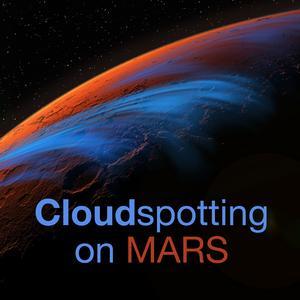Cloudspotting kicks off
Welcome! The Cloudspotting on Mars project offically launches today! If you’re intersted in searching the Martian sky for clouds, check out the project on the Zooniverse.
We’ll regularly share updates about the project on this blog, but today I’ll share a bit about how this project came to be. I’m a postdoctoral researcher at JPL who’s been focused on studying clouds that form high in the atmosphere of Mars. The Mars Climate Sounder (MCS) on the Mars Reconnaissance Orbtier (MRO) observes clouds that form in the middle atmosphere. We call these “mesospheric clouds” because they form in the “mesosphere,” the region of the atmosphere above the lowest layer where you see dust devils and other weather events but below the thermosphere, the upper fringes of the atmosphere heated by absoprtion of the Sun’s extreme ultraviolet rays. There are lots of questions about where these mesospheric clouds form, what enables them to form, what they’re made of, and how they affect the climate.
I set out to find all the mesospheric clouds in MCS’s data so that I could answer these questions. MRO has been orbiting Mars since 2006 and MCS continues its data acquisition today, accumulating more than 15 years of observations. The clouds appear in vertical profiles (a vertical slice) when looking at the “limb” (the horizon) of the planet. MCS has collected more than 100 million profiles to look through.
No problem! Machine learning! I’ll just have the computer find them for me. So I developed a few techniques to pick them out, which appeared to be working pretty well based on the examples I was working with. But how could I tell how well they were doing on the entire data set? What clouds was I missing? Which weren’t really clouds? Well, I needed ti establish a database of confirmed clouds picked out by eye that cover different times of day, seasons, and Mars years (some years have global dust storms!) in each of MCS’s spectral channels (which tell us about composition and other properties of the clouds). To start picking them out myself, I made an application where I could zoom in on the data, stretch the color contrast, click a few a buttons, and have the locations and times of the clouds saved to my computer. But there’s just too much data for one person to look at.
At this time, my advisor, Armin Kleinboehl, was teaching a class about atmospheric measurments and models at the International Institute for Astronautical Sciences (IIAS), an astronautics-focused citizen science institute. We presented the science case for studying Martian mesospheric clouds and the application I was using to search for them. Some IIAS citizen scientists were interested in helping us, so we sent the tool and some data around to the group and had meetings about completing the task. Technical difficulties setting up the application on each person’s computer proved too daunting challenge, but we were excited that the IIAS group was willing to help and they gave us some really useful feedback.
We learned a lot through that process and we proposed to NASA’s Citizen Science Seed Funding Program to adapt this tool for the Zooniverse’s platform. I was thrilled that we were selected! We got to work setting up the project on Zooniverse. Then, we reached back out to the IAAS citizen scientists to help us throughout the beta testing process. This was crucial and lead to what you’ll see today when you’re cloudspotting.
It’s been a long journey, but I’m looking forward to seeing where the project goes next. Before this project, I really had no idea of the extent of the citizen science community or ever-growing list of its accomplishments. I’m really grateful to NASA citizen science, the folks behind the Zooniverse, and the Citizen Science Association for a warm welcome into the community and for sharing lessons learned through many past projects.
I hope you enjoy searching for clouds in Mars’s atmosphere and I look forward to meeting you! If you’d like to receive updates about the project and future meetings, send an email to cloudspottingonmars@gmail.com and ask to join our email list.
See you out there, Marek
